In life…
It’s not about everything going right
but about facing what is going wrong.
It’s not about living without fear
but about having the courage to keep going despite it.
Remember that each day ends and brings a new
dawn filled with new and invigorating things.
Love what you do, do the best you can
and always remember how much you are loved.
Enrique Mondragón
ENRIQUE MONDRAGÓN
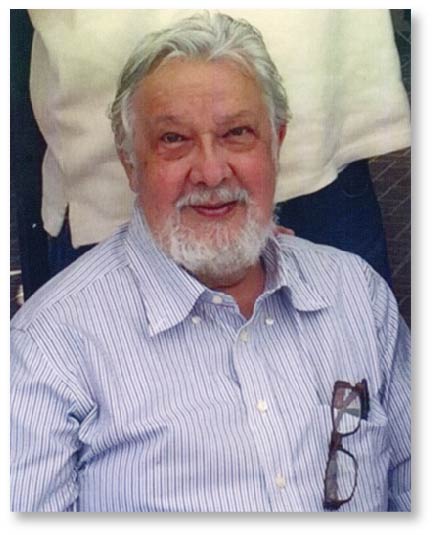
As it is common knowledge, artists in our country receive little support, especially painters, and they must fight against it all to exhibit and sell their artwork. Few reach the peak and some had to die for their paintings or murals to reach fame.
The story of Enrique Mondragón is one of sacrifice and tenacity: the painter of light and color – as his colleagues describe him – masters impressionism. With the spatula, he brings to his canvas the serene scenery, the fragrant flowers or the cadence of the ballet dancer. His Quixotes reflect the sadness and charm that the One-armed Man from Leopanto printed onto his scrawny character. Despite the official disdain towards artists and the scarcity of art buyers, Mondragón moves forward. His paintings, alongside those of Rufino Tamayo, Carlos Mérida and Raymundo Martínez, decorate the first-class suites of the Nikko Hotel.
Mr. Shogo Myzarawa, the manager of this hotel, expressed his recognition to Mondragón for his participation in the contest that took place to select the paintings that now decorate the luxurious hotel rooms, and in which more than 400 painters participated.
Some of the artworks of this Mexican plastic artist are part of private Japanese collections and he is one of the few painters that exhibit their work at the gallery of the Bellavista Golf Club, where numerous art enthusiasts acquire his paintings.
The persistent artist of infinite creation, who since 1971 has had, with exceptional success, exhibits in prestigious galleries in Mexico, Puerto Rico, United States, Canada and Germany, moves forward.
Félix Fuentes, director of the first
edition of the Ovaciones newspaper
CAREER

One of the greatest impressionist masters
of the third millennium
At the forefront of this style of painting, master Mondragón brings us back to the characteristics of impressionism: the simplicity in the forms, wide brush strokes, and the surprising composition; all united by the characteristic of the artist: his finished paintings seem to have been made in relief.
Mondragón paints since childhood. At the age of 14, he joins La Esmeralda, a painting and sculpting academy. He takes a diverse set of workshops – both independent and derived from the Instituto Nacional de la Juventud [National Youth Institute], as well as courses with both Angelina Beloff and Italian teacher Antonio Bologna, who teaches Mondragón the spatula technique – one which he continued to use even at advanced stages of his career.
This painter’s works, unlike those of the impressionist era, do have the classical finish and color gamma. He uses and works with a variety of greens, as well as reds, yellows, and blues. The sceneries remind us of Camille Corot, who, as well as Claude Monet, was categorized for painting out in the open.
Mondragón comments: “I enjoy painting outdoors in order to determine a canvas: the first phase takes me a couple of weeks and with the layers of oil paint already applied with the spatula technique, a few more weeks”. To traverse the exhibition is to be amongst flowers, wine cellars, and landscapes, as well as characters like Don Quixote and Sancho Panza, or even amongst vases filled with flowers: one of the public’s favourites, expressing both a direct relationship with nature and the essence of Mondragón’s art.
Eva Beitman
CRONOLOGY
The 1960’s:
the beginning of a great artist

“Mondragón’s paintings are incredible, he captures the school of impressionism in his artwork”.
Berta Hidalgo de Gilabert, writer and art critic.
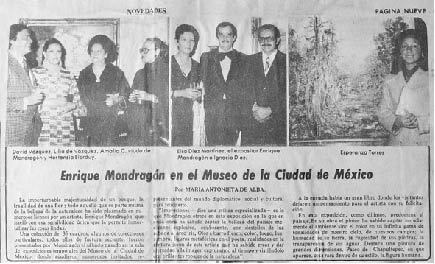
“Enrique Mondragón, rising star in contemporary paintings”.
María Antonieta de Alba, art critic.
“This artist has enriched the artistic scene of our city, offering an avalanche of paintings that speak of the author’s deep concerns, in which an expression of optimism and the joy of living are manifested, which is why his paintings invite us to contemplate them again and again”.
Berta Hidalgo de Gilabert, writer and art critic.
The 1970’s:
his talent begins to shine
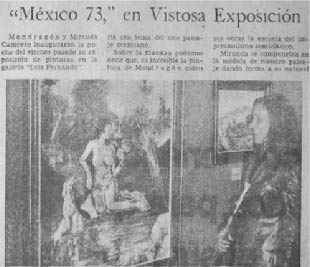
“In each of his paintings we find fluency of the lines, docility of the spatula, and mastery of human shapes and landscapes”.
María Antonieta de Alba, art critic.
The 1980’s:
an artist on the rise
“It has been affirmed that this is an artist who knows how to place the colour schemes where his paintings need them…author of light”.
Alfonso de Neuvillate, art critic.
“Painting is his life, his way of expressing his most hidden thoughts and feelings: his own way of seeing the world and those who surround him”.
María Teresa Santoscoy, art critic.
“Mondragón has placed himself in Mexico as one of the most enthusiastic followers of impressionism, since he is a persistent seeker of optical effects, and the beauty and variety of the Mexican landscape have been his starting point. In his paintings, the ‘Rembrandtness’ of his chiaroscuro training can be observed, using that Renaissance precision in his figures and landscapes”.
Eduardo Tamón, art critic.
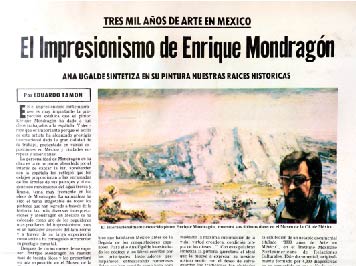
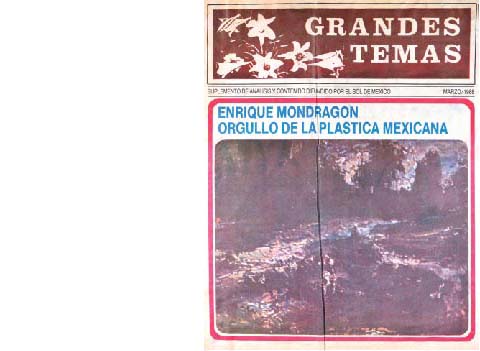
“Considered among the best Mexican landscapists”.
Alfonso de Neuvillate, art critic.
“Enrique Mondragón maintains an impressionist style, thus allowing our senses to travel to the most unexplored places of the planet. He explores diverse subjects that range from vagabonds to peasants that work in the fields, vases with beautiful flowers and landscapes. He generally tries to dignify the individual, showing their different facets and routine activities”.
Angélica Zamorano, art columnist.
“In my landscapes, which are what I do the most, I paint without atavisms, without following a school or trend; I follow in all my art the greatest plastic creator of all time and space: God, who created each and every landscape where his omnipotent hand is ever present, even in the tiniest beings of the universe”.
Enrique Mondragón.
The 1980’s:
from Mexico to the world
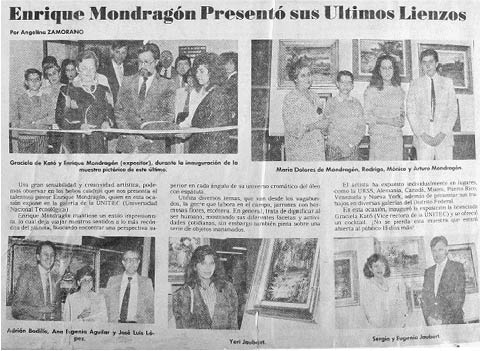
“Enrique Mondragón, impressionist painter that captures with the spatula the supreme instant of light and leaves thick illuminated textures in his paintings where colour projects and contrasts with the blank spaces that seem placed at random but that, unified by other shades, create the image desired by the artist”.
Eduardo Tamón, art critic.
The 1990’s:
the painter of light and color
“He who commits to painting can never be at peace. Art is something that cannot be abandoned, it lures in an incontrollable fashion and wakens a passion that removes all calmness from the spirit. One can only paint, and paint and paint”.
Enrique Mondragón.
“Mondragón’s artwork is characterized by the vibrancy that results from oil painting with spatula, the colours mix together and congregate in a polychromatic environment that creates an abstract sensation because of the texture in his paintings, even if the piece is artistically real, perfectly achieved by an impressionist style that is at the height of the greatest maestros of all time”.

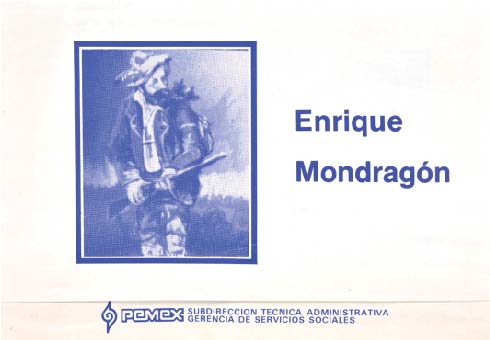
About oil painting and the spatula: “Through the many years I have learned the alchemy of colour, which is why there is no better teacher than the workshop”.
Enrique Mondragón.

“I only feel the need to paint and I do so as a way of revealing how much I love nature and the constant inspiration that it brings me to fulfill myself as a painter”.
Enrique Mondragón.
“I don’t need to see the signature to know that it is a painting by Enrique Mondragón”.
Eduardo Tamón, art critic.
The 2000’s:
the consolidation of the master
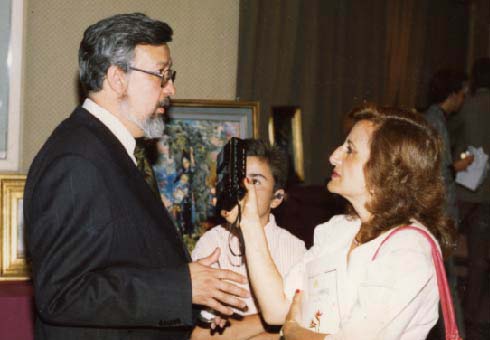
“Mondragón locks himself up in his studio and paints without feeling the passing of time”.
María Teresa Santoscoy, art critic.
The 2010’s:
the legacy of Mondragón

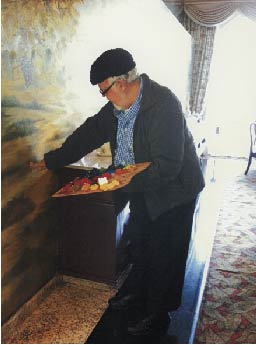
I remember that the first thing my son Diego painted were some race cars, he has always been drawn to them. However, Mondragón not only painted, he also loved singing, so one day he gifted my son a CD of Mexican music recorded by him.
Since I am a fan of park painters, some years ago I had the luck of finding him at the San Jacinto bazaar, where painters exhibit their work.
It was a pleasure to have known master Jorge Enrique Mondragón Castro, as he belongs to the fond moments of my past.
Thank you.

Mtro. Armando Manzanero
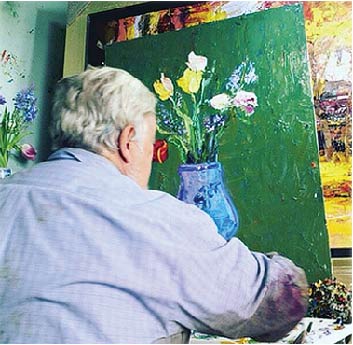
Words from a friend

Enrique Mondragón’s pictorial work surprised me from the very beginning for several reasons; firstly, because of the great quality in the treatment of colour in the landscapes, that in a way remind me of Odilón Redón’s work and the era of Saturnino Herrán.
Additionally, an impeccable use of the impressionist Mexican style that results from the combination of a great expressive force, an impeccable use of colour and an innocence of the poetic discourse that are observed intertwined in his work.
Moreover, with the capacity of transmitting an incredible tenderness in his flower paintings, Enrique would capture in his artwork, among other artistic qualities, his great human quality that made him, alongside his wife, a part of the cultural neighbourhood of San Miguel Chapultepec in Mexico City.
Although sometimes we didn’t chat much, we saw each other practically every day, crossing paths on the sidewalk of the Protasio Tagle street. Mondragón, the “Painter of Paintings” as he would introduce himself, would make us impatiently eager for the arrival of Christmas because he would always gift us a tray of meringues that wouldn’t last very long on the kitchen table. Enrique Mondragón always devoted himself to his art in a way that contrasted his discreet personality, but which was completely consistent with a man that was sensible, amiable, compassionate and above all, very human.
Sebastián, sculptor 
His unconditional and loyal partner
María Dolores Campero de Mondragón

Special mention to his wife, his loyal life-companion and unconditional support.

His family was always his inspiration,
support and priority.


